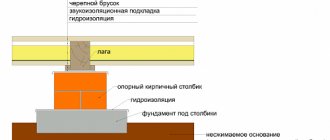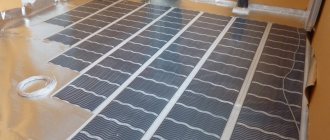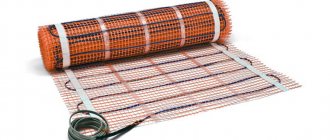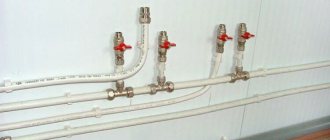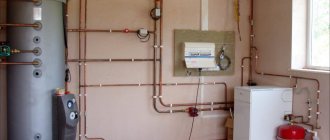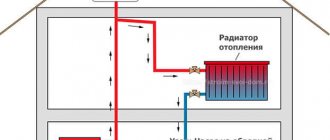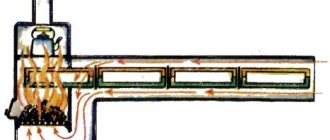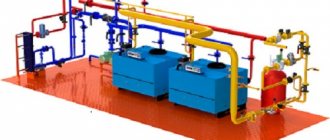Attic heating
Attic is an attic-type room in residential buildings. Carrying out utilities and heating the attic are the necessary conditions for the comfortable use of the room as a bedroom, playroom, nursery, office. The attic heating system solves a number of tasks:
- maintains a stable positive temperature in the cold season,
- does not allow freezing of the room,
- prevents the formation of ice and a decrease in the performance of building and finishing materials.
Correctly designed attic heating in the house consumes a minimum amount of energy, does not increase its consumption during the heating season, allows you to regulate the temperature in the room and is responsible for a healthy microclimate.
Heating the attic: modern methods
There are several ways to heat the attic in a bathhouse and a country house. The first of them is the connection to the common boiler room of the cottage. A pipeline is laid in the attic, radiators are installed through which the coolant circulates - water heated in the boiler room. When choosing the best way to warm up the room, it is recommended to take into account the following disadvantages of the attic water heating system:
- The load on the boiler increases: if initially it was not designed to heat the attic, then the temperature in other rooms will drop, and fuel consumption will increase.
- The attic is removed from the boiler: the coolant reaches the attic with a lowered temperature, having already given off heat to other rooms. This reduces the efficiency of heating the attic, or leads to the need to install a large number of radiators.
Benefits of using solar energy for attic heating
- Autonomy.
Solar heating equipment does not need to be connected to the mains or use any other fuel. - Ease of installation.
Products are installed on walls or roofs. Installation is simple and quick, no complicated project documentation is required. - Effective work.
The devices maintain a positive attic temperature throughout the autumn-winter period.
Attic heating with solar energy is used in residential buildings in the USA, Canada, Russia, Europe and the CIS.
Insulation of the attic floor with sawdust
Sawdust - finely ground wood.
- naturalness;
- lack of toxic impurities;
- light weight;
- availability of material.
Attic insulation technology with sawdust
before proceeding with the insulation with sawdust, they need to be prepared. Namely, mix cement and water with sawdust in a ratio of 10: 1: 1.
Pour the attic floor with the ready-made mixture and level it. It is worth noting that sawdust can be used as insulation without using a frame only in a non-residential attic. Otherwise, when walking on the floor, the sawdust will be compressed, and the concrete screed will collapse.
build a cellular structure from a bar. Pour a solution with sawdust into each cell. The advantage of this method is that a sub-floor can be laid over the timber. And the attic will be usable
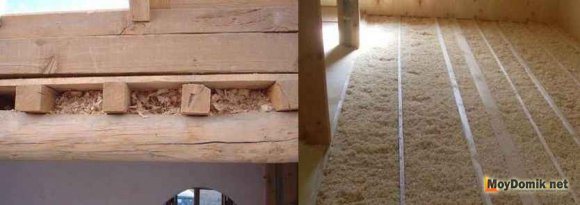
Insulation of the attic floor with sawdust
Warming
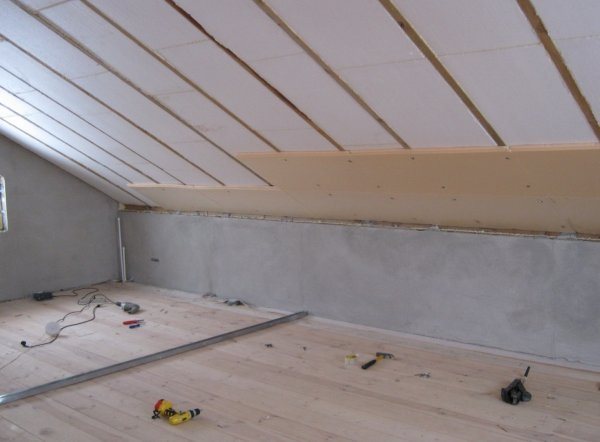

One of the simplest and relatively cheap techniques. A layer of thermal insulation is mounted from the inside, and the most commonly used material is expanded polystyrene plates. Their fastening has its own peculiarity due to the rigidity of the samples. The natural shrinkage of the wood must be taken into account. With regard to the attic, this mainly applies to the rafter legs.To avoid further deformation of the heat-insulating layer, the plates are fastened with a gap of about 5 mm. The joints between them are sealed with polyurethane foam - the most convenient and effective technique.
Judging by the correspondence on the forums of the corresponding orientation, then with high-quality insulation of the attic, additional heating may not be needed at all. Is that heating in severe frosts. And that is not a fact.
With this method of insulation, it is desirable to regulate the humidity in the attic. With its increased value, fungus and mold develop on expanded polystyrene, which will gradually move to the facing of the walls and ceiling.
Minvats for insulation of the attic are used less often. The main reason is the need to ensure high-quality waterproofing of surfaces, since all types of products in this group are hygroscopic. That is, they absorb liquids.
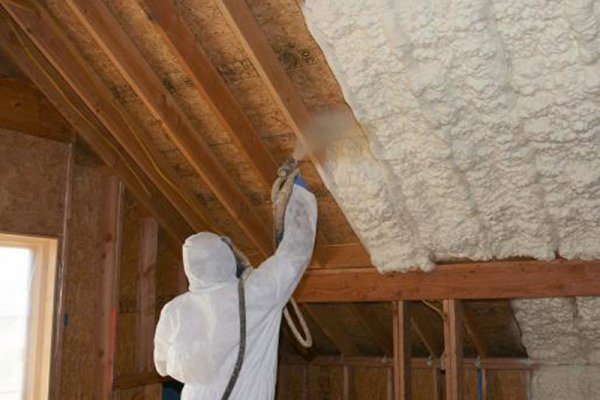

Polyurethane foam... This is a spray-on thermal insulation. Its effectiveness, with a competent approach, is maximum. The difficulty is that you need to purchase the appropriate equipment or invite specialists with your own. And this is an additional cost. There is one more negative point - low maintainability. If the plates (mats) are easy to replace, then with polyurethane, which is firmly seized to the base (glued), it is much more difficult.
What to consider... One of the most difficult questions is choosing the optimal thickness of insulation. Firstly, this layer (plus the cladding) conceals the usable area of the attic. Secondly, few people take into account such a factor as the position of the dew point. An illiterate calculation of the parameters of a heat insulator can lead to the fact that moisture will condense in the room. As a result - constant dampness in the attic with all the ensuing "delights".
Installation of a heating boiler in the attic
- Is it generally possible to install heating boilers in the attic and second floor of the house? According to experts, this is not the best option, but in extreme cases, if there is no other way out, you can go for it, observing certain conditions;
- Which boiler can be installed above the first floor of the house? With a closed combustion chamber! It is much safer than the traditional one, although it costs half as much. Condensing boilers are suitable in which the combustion chamber is always closed. In this case, there will be no risk of carbon monoxide poisoning, and the room will not cool down during the operation of the boiler;
- It's clear about a closed combustion chamber, but still, which boiler is ideal for installation in the attic? Wall gas, up to 30 kW. Such boilers are compact, do not take up little space, they do not need a separate room. The specified capacity will be quite enough to provide heat in a cottage designed for one family, that is, relatively small. The main thing is that the wall can support the weight of the boiler. However, we solve this issue even in frame buildings;
- And if the boiler runs on solid or liquid fuel, not gas, can it be installed in the attic? In theory, yes. However, think about how you will service the solid fuel boiler on the top floor? You will have to constantly carry briquettes, coal and firewood up the stairs. Yes, and solid fuel boilers weigh a lot, it will be necessary to strengthen the floors. Liquid fuel boilers make noise and give off an unpleasant odor, so they are categorically not suitable for installation on the upper floors;
- What should be the chimney if the boiler is installed in the attic or on the second floor? There may be problems here. In general, the height of the chimney for a gas heating boiler should be at least four meters. Imagine if such a pipe will rise above your roof. This can ruin the look of your home. You can get rid of the need to build such a high chimney if you choose a boiler with a closed combustion chamber, which has a coaxial pipe.For boilers up to 30 kW, which we recommend for installation in attics and second floors, you can lead the chimney directly through the outer wall. In this case, the pipe outlet should be located at a height of 2.5 meters from the ground, but in the case of an attic, this is not a problem. The nearest window from the chimney that goes through the wall must be at least half a meter;
- What should be the heating system if the boiler is installed above the first floor? Closed! This is a prerequisite. With an open heating system, when the circulation of liquid in the system occurs naturally, all heating devices are located above the boiler itself. In the case of installation in the attic or second floor, this condition for the normal operation of the heating system cannot be met. Therefore, it becomes mandatory to install a circulation pump, which will become part of a closed home heating system;
- Will there be enough natural ventilation for the boiler in the attic? In general, yes. But for greater reliability and safety, experts advise making an unclosed hole 30 centimeters from the floor. An exhaust vent is made under the ceiling. The total area of such ventilation should be at least 200 square centimeters.
We state: a wall-mounted gas boiler with a closed combustion chamber and a circulation pump, in addition, can be safely installed and used in the attic or second floor of a private house. published by econet.ru
If you have any questions on this topic, ask the specialists and readers of our project here.
Attic floor heating
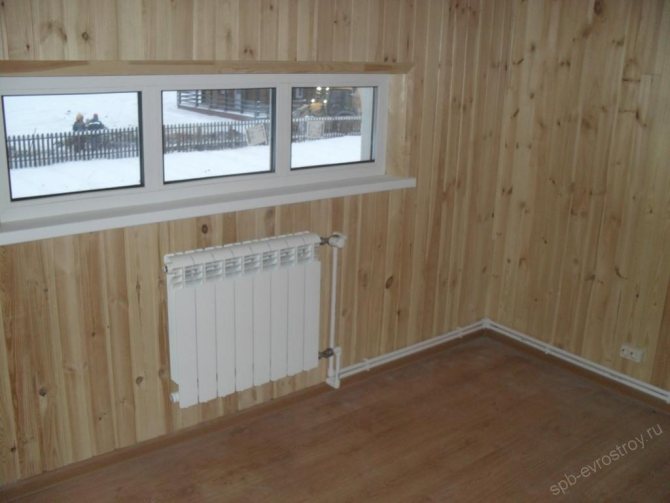

While the ground floor can be efficiently heated by using the combined option, heating the attic house requires a more “gentle” approach. The fact is that the use of a "warm floor" system is inappropriate here due to the high total cost (if it was previously installed on the ground floor).
The heated warm air from the lower tier will definitely rise upward, and partially warm the upper floor. For this reason, the installation of a "warm floor" in the attic is not cost-effective. It is enough to install ordinary radiators.
Attic life under the roof
Usually the attic becomes such a favorite place in the house that there is a desire to spend time in it not only in summer, but also when there is a severe frost outside the windows. Therefore, often the owners of attic houses have a need for heating in the upper part of the house. There are different ways to provide good heating, not forgetting that the attic must already be insulated.
Connection to the heating system of the lower floor
In this case, one system will heat the whole house. If before that the parameters of the pump and the boiler were calculated only for their use on the same floor, the equipment should be replaced with a more powerful one. In the attic from the basic heating system, the necessary components are additionally brought out - pipes and radiators, and in case of air heating - air ducts.
Electrical devices
It is not economical to use old-style electrical appliances due to the high energy consumption, which is not cheap. Modern electric convectors can reduce costs. Their installation is straightforward: you just need to choose a place for the device and connect it to the mains. Energy saving is carried out due to the fact that the convector does not work constantly.
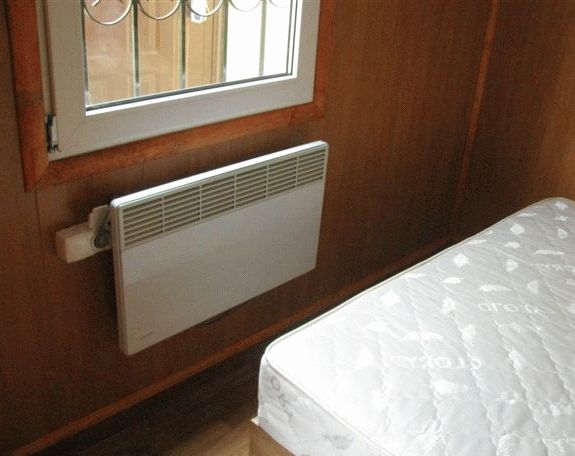

Wall-mounted electric convector for your attic
The owner sets the temperature indicator to which the air should be heated. When the device's sensors record that the temperature has reached this level, the convector switches off until the indicators drop. However, it must be borne in mind that for heating the attic, such a device may need more than one, and this will create an additional load for wiring and increase costs.
Heating by fireplace
Having decided to use this heating option, you need to remember that the weight of the fireplace is not small. Consequently, the floor at its location will have to be strengthened. To reduce the pressure on the floor, it is recommended to use a fireplace with light pipes in the attic.
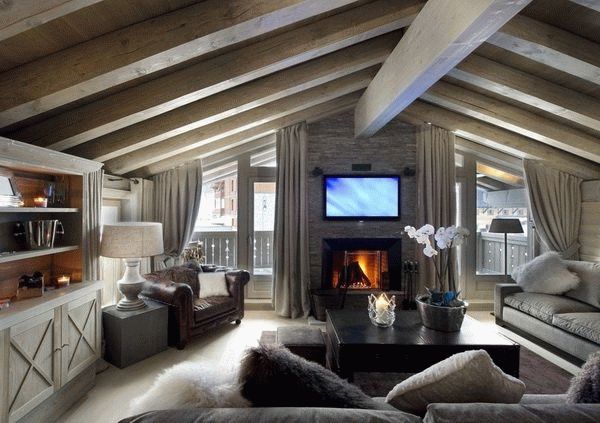

The fireplace in the attic also performs a decorative function.
You also need to be prepared for the fact that using a fireplace as a heating agent in the attic, you will have to constantly bring heavy fuel to the attic floor and take down its waste, making additional efforts.
Heating system
The method consists in creating a system intended only for heating the attic. This option is suitable for attic conditions, especially if a stove is used to heat the first floor, or it is not possible to connect to the main heating main of the house.
In a heating scheme of this type, the main place is occupied by a boiler that runs on any available fuel. Other elements of the system are pumping equipment, a complex providing air intake and removal of waste products, pipelines, and the necessary fittings.
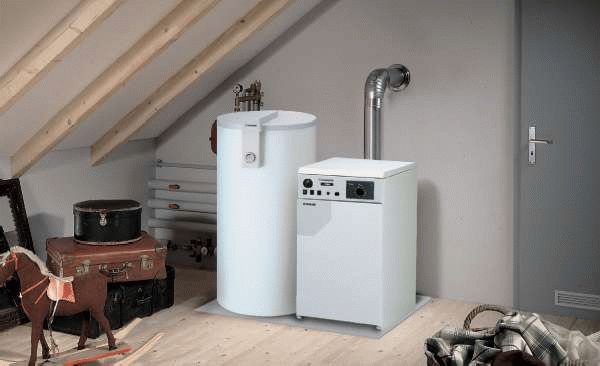

The heating boiler in the attic looks pretty good
It is important to decide on the type of circulation. If it is natural, then it is assumed that there is no pump that consumes energy, which is an advantage
But at the same time, this option has many disadvantages, including the increased diameter of the pipelines, the immutable observance of the slopes, certain difficulties in control.
It is most convenient to use a two-pipe scheme in the attic with a pump that provides forced circulation - it will contribute to optimal heat distribution.
Warm floor
This system is based on the property of warm air to rise upward. This way you can make your attic floors truly functional! Heating is carried out due to the uniform distribution of heat transfer components in the floor space. These can be electrical cables or pipes containing heated water.
Cables are installed with any type of coverage. If the floor is wooden, a layer of thermal insulation is placed between the logs, a mesh with a laid cable is suspended above it. A covering is laid on top. Cable heating is a good option for use in an attic room.
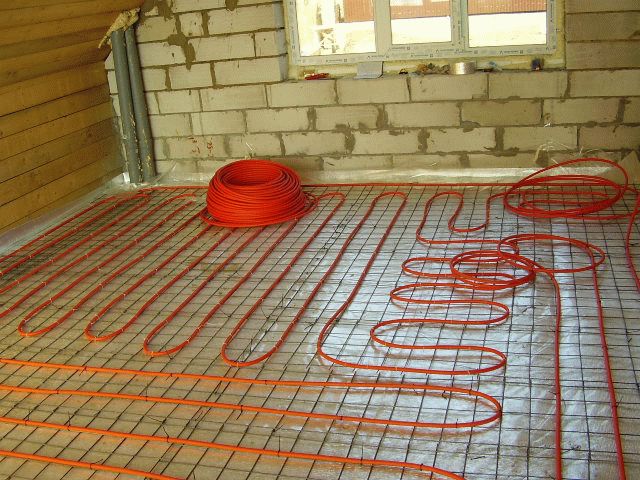

Installation of underfloor heating in the attic
The water method of heating the attic is used less often. This is due to the creation of a large load on the floor. To support the weight of the entire heating system, the ceiling must be concrete. The boiler is used as a source of water. Such a system is more often used for autonomous heating.
Thus, attic owners have the opportunity to choose the appropriate way to maintain heat, which will contribute to the creation of coziness and comfort.
Heating regulation on floors and in rooms
In order to be able to regulate the temperature on floors and individual rooms, manufacturers of heating equipment offer their customers to purchase special sensors (wired and wireless) connected to various circuits of the heating system.
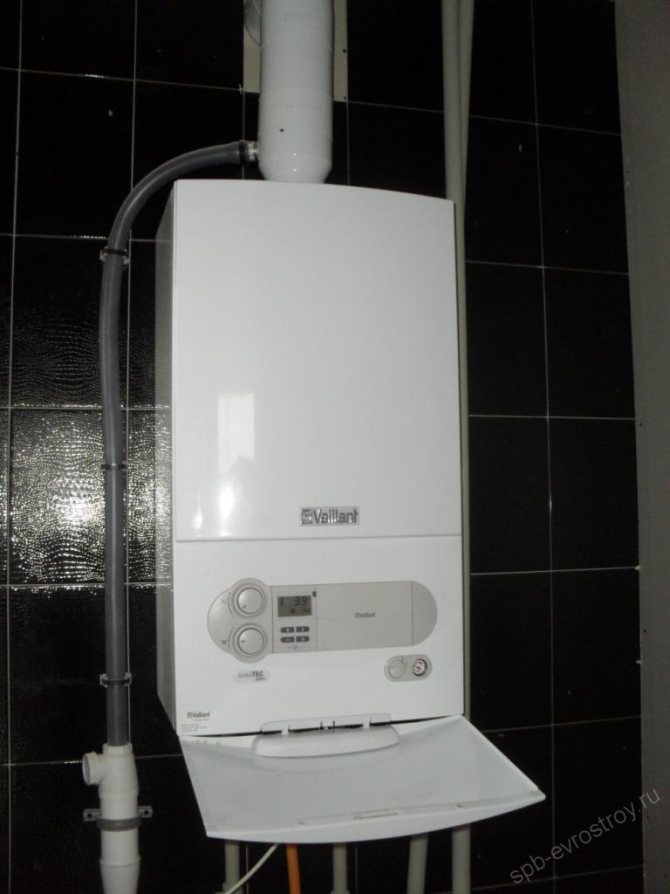

In addition, so-called thermostatic heads can be installed on each radiator, which can be adjusted to a specific response temperature. If it is exceeded, the head mechanism will block the flow of coolant to the radiator, and if it drops, it will open it.
Floor-by-floor heating control is carried out by installing special thermostats and electronic regulators in the corresponding circuits, which have the function of setting the desired temperature.
The installation of such regulators (electronic, mechanical) at the entrance of each floor makes it possible to shut off and regulate the supply of the coolant, thereby providing significant savings in financial resources that the building owner spends on heating. So, if not necessary, you can completely turn off the heating of the attic floor.
Contact us!
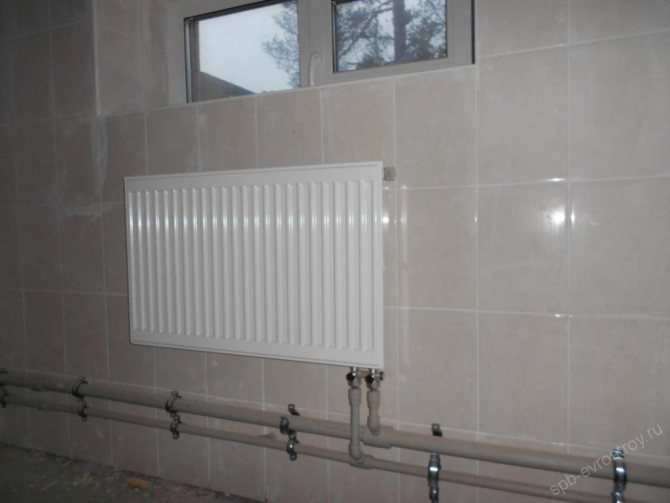

A house with an attic needs high-quality heating, since the additional floor takes up almost half of the usable area of the building. Therefore, when calculating and installing, it is necessary to take into account all the subtleties and nuances. Go to the page - the cost of gas heating.
The specialists of our company, possessing many years of experience and appropriate qualifications, will qualitatively perform the installation of gas heating equipment, as well as adjust it to the optimal operating mode.
Upon completion of the work, we provide consultation regarding the use and maintenance of heating boilers of any type.
admin
We heat the attic or how to make heating in a house with an attic correctly
There are two ways to use a country house - to live in it periodically, for example, only in the summer, or permanently. Today we will analyze the second option, in particular, we will focus on projects with an attic floor. In this case, effective heating will also be needed for the attic space, which can be autonomous or connected to the general heating system of the house. Let's consider it in more detail.
In the photo - ways of heating the attic floor
Preparation
In any case, we first need to properly insulate the attic, otherwise the cost of heating it will be very large. Since the floor is located in direct contact with the roof, it is imperative to carry out work on its thermal insulation.
- mineral wool,
- polyurethane foam,
- polystyrene class G1,
- foamed polymers.
Advice: treat the attic insulation with special attention, the better you do it, the more comfortable the living conditions on it will be, and also less money will have to be spent on additional heating. High-quality heating is impossible without proper roof insulation
High-quality heating is impossible without proper roof insulation
Heating system selection
If the house is just being built, it is necessary to provide for the heating of the attic floor at the design stage. However, as construction practice shows, most often the attic is turned into an additional living area after the completion of all work.
In this case, you cannot do without additional costs associated with the wiring of the necessary communications and the choice of the optimal option for heating the room:
- underfloor heating system,
- installation of a fireplace,
- autonomous heating system, the price of which may be different,
- connecting the floor to the finished heating system of the house.
Do-it-yourself attic heating with infrared panels
What to look for
Whatever you choose, you must first develop a heating system project, in which you try to take into account all the structural features of the building, the need for materials, their cost and quantity.
The heating scheme for a cottage with an attic will make it possible to understand:
- where to install the necessary equipment,
- how to lay pipes so that you can get the maximum effect from the distribution,
- in what place is it better to place ventilation.
General heating scheme for a house with an attic
Feel free to seek professional help to get a safe and effective system. Although, if you have certain abilities and the necessary materials, you can make heating the attic floor with your own hands.
- boiler,
- circulation pump,
- pipelines,
- systems of air supply and removal of fuel combustion products.
The heating boiler should be selected depending on the availability and ease of use of certain fuels. Its capacity must correspond to the size of the room. You can calculate them yourself or get them from specialists.
Advice: standard calculation of heating power - 1 kW is required for 10 m 2. In this case, the height of the ceilings is taken to be 2.5-2.7 m.
Stove or fireplace
An excellent option for a heat source in the attic, which can also become an interior decoration. It remains to solve the main question before arranging the fireplace - whether its floors will withstand, since the structure has a significant weight. It may be necessary to carry out work to strengthen them.
Using the fireplace as a heat source
Tip: The load can be reduced by using metal pipes and lightweight refractory bricks.
You can also purchase ready-made cast iron or steel structures. Such fireplace stoves are capable of making a comfortable room temperature up to 200m2.
- objects of increased fire hazard,
- the arrangement requires the use of non-combustible materials in the interior, correctly installed chimneys and high-quality ventilation.
Tip: to reduce the risk of fire, install structures from walls at some distance or place them in the middle of the room.
Using an electric fireplace requires little maintenance and is safer, although electricity will increase heating costs. To reduce them, you can install convectors that automatically turn off after reaching a certain temperature in the room.
Installation of a steel convector for hot water heating
A house with an attic floor has an excellent appearance and can be used all year round or from time to time. A properly executed heating system allows you to create a comfortable temperature in the room under the roof.
A common option for heating the first floor
Typically, the lower level of a two-story house is heated by a combined system:
- radiators
- underfloor heating system
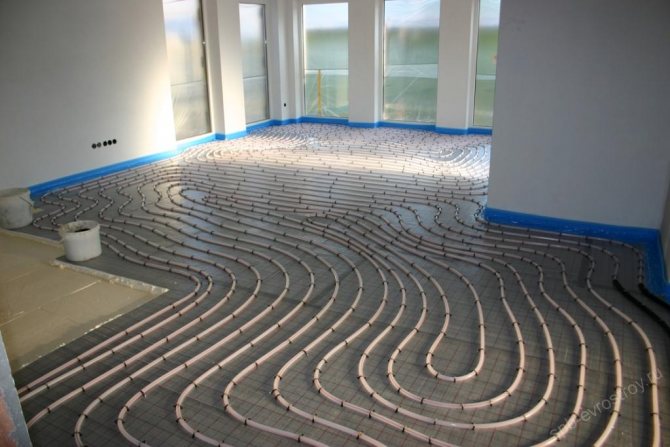

This combination allows you to fully heat the lower floor and ensure a comfortable temperature for all rooms. In some cases, the underfloor heating is powered by a separate gas boiler, which makes it possible to increase the reliability of the entire heating. Read more about installing a warm floor.
But often in private houses there is also the option of heating only with radiators.
Features of the event
Usually, only the ceiling is insulated in a cold attic. Then the roof rafter system is left open so that it is possible to freely inspect it and correct any problems that have arisen. If you insulate the roof with mineral wool, then this already turns out to be an attic, which can be used for a different purpose than an attic.
It is very important that the insulation is done correctly, otherwise condensation will form. If it collects on the ceiling, moisture will seep through the ceilings.
Mold and mildew may develop. And the rafters will rot from the inside.
When using mineral wool as insulation, consider its weight. The ceiling, floors must withstand the expected load with a margin, the structure must be reliable.
On the video insulation of the attic floor with mineral wool instructions:
When planning work, make calculations: how much material do you need to purchase? Its amount depends on the area on which the material will be laid and the number of layers. The thickness of the insulating layer depends on the climate of the region.
Step by step instructions
First, prepare the "territory", clear the floor from possible debris, thyrsa. Metal elements of the roof should be painted with oil paint to prevent condensation from accumulating on them.
Then a lining material is laid on the floor as a vapor barrier layer.If it is not there, the mineral wool will absorb all the moisture from the warm humid air that rises from the living rooms.
Over time, it will lose its thermal insulation qualities. A budget option is to use glassine, a vapor barrier film will cost more. You need to lay it with a little overlap, fix the joints (glue with tape or secure with wooden slats).
Place mineral wool between the logs tightly, without gaps and crevices. The joints of the material also need to be glued with tape.
Put clean, dry, even boards on top of the logs. They will be the floor in the attic. And the mineral wool will be ventilated, "breathe" under them, dry in case of moisture.
Such installation is sufficient if waterproofing material is laid under the roof and there are no cracks in the attic.
If there is no waterproofing material under the roof, then it is worth covering the heat-insulating mineral insulation with a vapor barrier. The easiest way is to attach the plastic wrap with thin transverse beams.
Minvata is ideal for insulating wooden floors. You can use any kind: in rolls or in slabs. Choose a material of the required density, follow the instructions when laying, then the room will be warm and comfortable for a long time.
Warm floor
This system is based on the property of warm air to rise upward. This way you can make your attic floors truly functional! Heating is carried out due to the uniform distribution of heat transfer components in the floor space. These can be electrical cables or pipes containing heated water.
Cables are installed with any type of coverage. If the floor is wooden, a layer of thermal insulation is placed between the logs, a mesh with a laid cable is suspended above it. A covering is laid on top. Cable heating is a good option for use in an attic room.
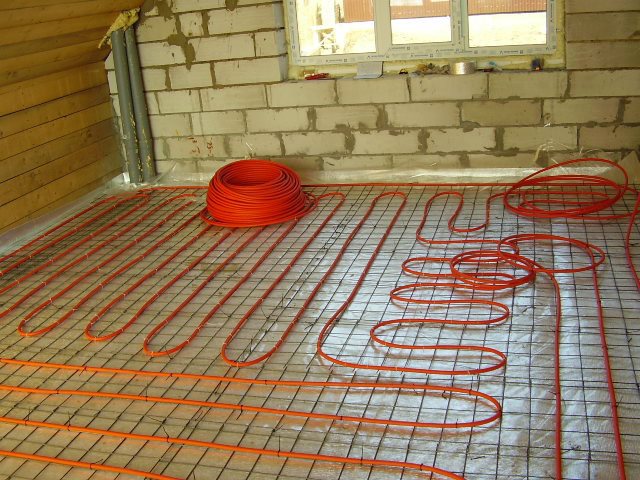

Installation of underfloor heating in the attic
The water method of heating the attic is used less often. This is due to the creation of a large load on the floor. To support the weight of the entire heating system, the ceiling must be concrete. The boiler is used as a source of water. Such a system is more often used for autonomous heating.
Finally, I would like to recommend to your attention an informative video that will tell you in full about the methods and intricacies of heating the attic:
Thus, attic owners have the opportunity to choose the appropriate way to maintain heat, which will contribute to the creation of coziness and comfort.
Types and characteristics
The material is obtained from molten blast-furnace slag, stone (rocks) or glass. In structure, these fibers are thin randomly arranged villi, from 2 to 60 mm long. This insulation is produced in the form of mats or plates. So that the fibers are better adhered to each other, the plates are additionally impregnated with special oil (to repel moisture) and phenol alcohol.
Depending on the origin, they differ:
- Glass wool. It is made from a molten mixture of broken glass, sand, limestone, soda. The fibers are 15-50 mm long, and their thickness is 5-15 microns. The material is chemically resistant, hardly flammable (withstands up to +500 o C).
Stone wool. For its manufacture, gabbro-basalt rocks are melted. The thickness of the fibers is 4-12 microns, and they are up to 16 mm in length. It heats up, without igniting, up to 300 o C.
Insulation of a cold attic with mineral wool
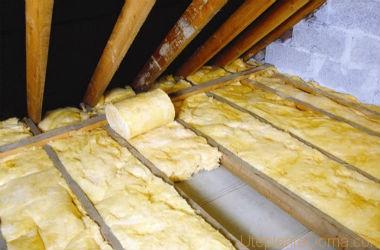

A vapor barrier is placed under the mineral wool.
To insulate the ceiling of a cold attic with mineral wool, you can take material of any density, from low to high. In this case, it is still preferable to dwell on lighter materials so as not to create additional loads on the beams.Some experts are inclined to believe that glass wool is better suited for insulating an attic with rock wool than stone wool. The latter is too fragile, and its weight is considerable. Also read: "How to choose a heater for walls and ceilings."
As you already understood, the insulation of the cold attic of a private house with mineral wool is performed by laying thermal insulation between the load-bearing beams directly on the rough ceiling of the first floor. Due to the high hygroscopicity of mineral wool, it is necessary to use a vapor barrier film. In principle, even plain polyethylene can be used. There will be no special loads on the film and with careful installation it will not tear. To be completely sure of the reliability of the protective layer, you need to use a polypropylene vapor barrier reinforced with fiberglass mesh.
Insulation of the attic with mineral wool, technology:
- the bearing beams are sewn up from below - this is the rough ceiling of the first floor;
- from the side of the attic, a vapor barrier is laid on the rough covering;
- mineral wool is placed on top of the film.
The vapor barrier tapes should be overlapped, the joints are glued with double-sided tape. The minvata is placed by surprise so that there are no cold bridges in the places where the insulation is adjacent to the beams.
Thermal insulation of a cold attic with mineral wool is always preceded by a calculation of the thickness of thermal insulation. In any case, the layer will be at least 10 cm. Mineral wool is produced with a thickness of 5 cm. It is better to lay the thermal insulation in two layers with an offset of the joints. This will eliminate the possibility of heat loss through the joints of the mineral wool sheets.
After insulating the attic floor with mineral wool, you can immediately lay the floor over the beams. It is advisable to close the insulation with waterproofing before that - a material that does not allow water to pass through, while allowing steam to pass through, but only in one direction
It is important not to confuse which side to lay the waterproofing on, otherwise moisture will accumulate in the mineral wool, as a result of which the thermal conductivity of the material will increase significantly
It is quite possible to use a fireplace to heat a country house. For this, a heat exchanger is built in above the firebox.
Read about how to select the dimensions of the radiator brackets here.
Mansard roof insulation and dew point
If we consider the ideal option, then it is better to insulate the attic roof from the outside, and even at the stage of construction of the roofing pie. But in most cases, they already think about internal thermal insulation when the building is covered with a roof. And here some difficulties appear.
The correct roofing cake consists of several layers of a variety of materials, which are tightly stacked on top of each other without gaps in the rafters. This sandwich ensures that the dew point is on the outside. As a result, all condensate that occurs outside quickly evaporates into the atmosphere.
When arranging the thermal insulation of the attic from the inside, it is important to organize a space between the insulation and the roof for ventilation and evaporation of condensate, which is formed as a result of temperature changes.
When constructing internal insulation, after installing the roof, it is impossible to create the above-described sandwich, because it will not work to press the insulator to the structure so that there are no voids left between them.
In this case, steam is always directed to the cold zone, and then moisture and condensate will begin to collect in each cavity. And this will lead to damage to the insulation itself and the wooden rafters of the structure.
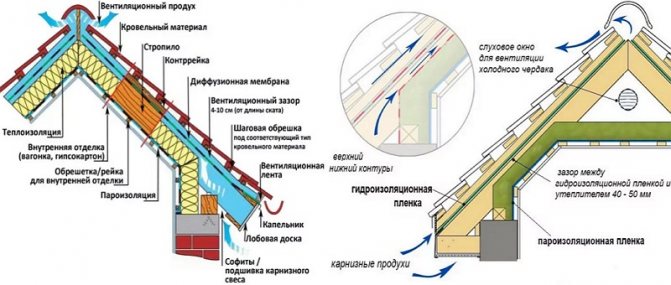

When insulating the attic from the inside, the dew point must be shifted to the space between the roofing deck and the thermal insulation material, maintaining a gap of 5-10 cm for effective ventilation. Only adherence to such a technology and only such a roofing cake will make it possible to protect against moisture absorption by a heat insulator.
To organize the correct air exchange in the under-roofing zones, you should install a deflector on the ridge and provide for special holes in the cornice.
To reduce the volume of water vapor in the heat insulator, it must be placed together with a vapor barrier film. The vapor barrier is laid from the inside of the attic on top of the insulation.
The vapor is first forced to meet this film, while most of it must remain indoors. The less steam penetrates into the material layer, the better.
Thermal insulation of heating pipes in the basement Pipes and plumbing
House heating costs increase every year. Each owner is looking for ways to save money: the boiler turns on periodically, or constantly works only at a minimum, and so on. The use of such methods leads to a significant decrease in the temperature in the house. But few people think about how efficiently the residential area is heated, because most of the heat is lost on the way to it.
If heat losses can be minimized, then the rooms will warm up better and faster, accordingly, continuous operation of the boiler will not be required, and it will be possible to resort to savings without affecting the temperature. Since boilers are often located in basements and other utility rooms, we will consider how to insulate heating pipes in the basement and other possible places where the system passes.


